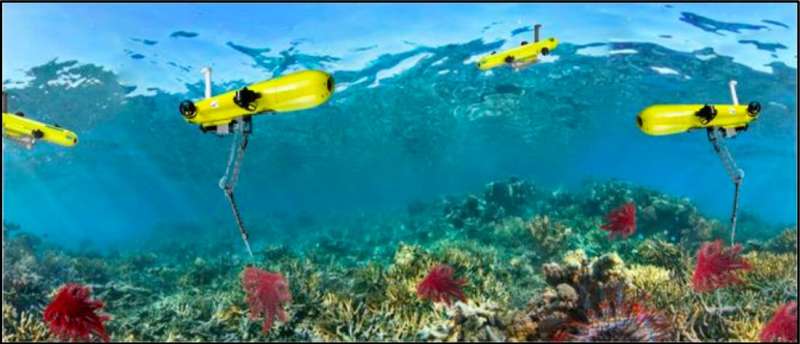January 29, 2021 feature
Using AUVs to control the outbreak of crown-of-thorns starfish in Australia's Great Barrier Reef

Over the past few decades, people around the world have been dealing with a vast variety of environmental threats. In Australia, these include risks associated with the deterioration and destruction of aquatic plants, animals and other organisms that inhabit surrounding seas and oceans.
Monitoring underwater life has always been a priority for both the Australian government and for environmentalists based in Australia. One of the underwater threats that Australia is currently facing concerns the Great Barrier Reef, the world's largest coral reef, located off the coast of Queensland in the Coral Sea.
In recent years, over 50% of the Great Barrier Reef was destroyed by crown-of-thorns starfish (COTS), large marine invertebrates covered in long, poisonous spines. These spiky and colorful starfish are known to eat coral polyps, which reside on coral reefs.
Researchers at Deakin University and Murdoch University in Australia, as well as Azad University of Khoemeinishar in Iran, have recently investigated the possibility of managing the propagation of COTS around coral reefs using autonomous underwater vehicles (AUVs). In a paper pre-published on arXiv, they presented an approach that allows multiple AUVs to cooperate on the task of monitoring and controlling the presence of COTS around the Great Barrier Reef to prevent further damage to it.
"This paper presents a cooperative dynamic task assignment framework for a certain class of AUVs employed to control the outbreak of COTS in Australia's Great Barrier Reef," the researchers wrote in their paper.
Initially, Amin Abbasi, Somaiyeh MahmoudZadeh and Amirmehdi Yazdani, the three researchers who carried out the study, closely considered the problem of monitoring and controlling COTS in the Coral Sea. Subsequently, they introduced a framework that proposes to solve this problem using a specific type of AUV, which they call COTSbots.
COTSbots are unique underwater robotic systems developed at Queensland University of Technology (QUT), equipped with onboard cameras, a computer vision system and a foldable robotic arm with a long needle at its end. The robot navigates underwater in specific areas around coral reefs using a GPS system to orient itself, and collects images underwater using its onboard cameras. The images are then analyzed by an artificial neural network trained to detect the presence of COTS. When the system detects the coral-eating starfish, it injects them with lethal bile salts using the needle at the end of its robotic arm.
As part of their study, Abbasi, MahmoudZadeh and Yazdani designed a probabilistic map of the environment around the Great Barrier Reef that COTSbots would be operating in, delineating seabed terrain, clusters of COTS and coastlines. They then developed a heuristic algorithm called Heuristic Feel Cooperation (HFC), which allows COTSbot AUVs to cooperatively exterminate as many COTS as possible within a specific amount of time.
The researchers evaluated their cooperative dynamic task assignment framework in a series of simulations. In addition, they ran quantitative performance analyses to test the performance of the HFC algorithm. The findings they gathered so far are promising, as they highlight the effectiveness of their framework for controlling the outbreak of COTS in specific areas.
"The results of a Monte Carlo analysis confirmed the stability and robustness of the planner in dealing with random deformation of the COTS distribution and environmental topology," the researchers wrote in their paper. "Moreover, the result of the comparative study demonstrated the superior performance of the HFC algorithm against the benchmark GA-based task assignment method."
In the future, this framework could help to monitor and eradicate clusters of COTS threatening the survival of Australia's Great Barrier Reef. So far, Abbasi, MahmoudZadeh and Yazdani have only evaluated their approach in simulations. However, they are now planning to conduct a series of field trials to test its effectiveness in the real world.
More information: A cooperative dynamic task assignment framework for COTSBot AUVs. arXiv:2101.03696 [cs.RO]. arxiv.org/abs/2101.03696
© 2021 Science X Network

















